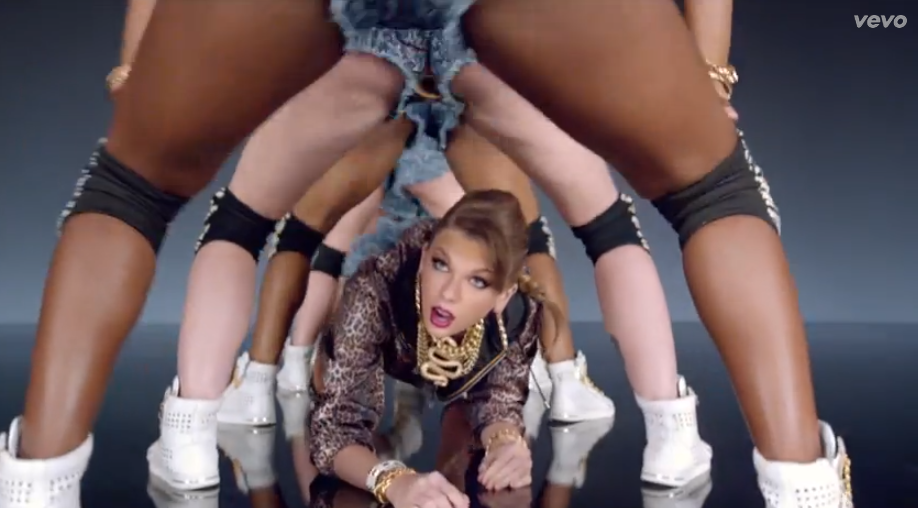Country singer Taylor Swift, the poster girl for whiteness, on Monday officially became a pop star when she released her music video for “Shake It Off,” her first official single from her “first documented, official pop album,” the upcoming “1989.” The song, though catchy, is unremarkable, but the music video has been generating controversy across the Internet thanks to some scenes in which Swift appears with twerking backup dancers.
The video starts out as expected: Swift, as a ballerina, sings about her reputation: “I’m too late/Got nothin’ in my brain/That’s what people say.” But, as if to burst out of her boxed-in country girl persona, she sings, “I’m dancing on my own/I make the moves up as I go/And that’s what they don’t know.” The metaphor is clear, she’s “dancing to the beat of her own drum,” as the cliché goes, and that beat gives way to twirling batons and dressing in some futuristic space outfit à la Lady Gaga. But as the video progresses, we see that Swift is actually a terrible ballerina, is bad at twirling, and generally has little aptitude for dancing. Her lyric, “I’m lightning on my feet/and that’s what they don’t see,” suggests that her critics maybe do have her pegged correctly, but she doesn’t care either way. It’s another commentary on her music and her image that lends itself to her “I’m not a popular girl” persona.
The point of controversy is when Swift appears with a crew of black backup dancers who twerk and break-dance around her. In one scene, Swift crawls under an archway of black women’s asses as they twerk for the camera.
Forrest Wickman at Slate defends the scenes, writing that it’s still part of the same joke. “Later, when she’s shaking her booty beside some twerking dancers (batten down for the think pieces) she positions herself as the anti-Miley,” he writes. “The message isn’t that she’s down with them. The message is that she could never appropriate something like twerking and make it convincing. Everyone knows she’s a bad dancer, so she gave her haters a whole video of bad dancing.”
Indeed, Swift digs into Cyrus in one scene, when she sings a Cyrus lyric, “Can’t stop, won’t stop,” as a black woman twerks for the camera. But in these scenes, are we laughing at Swift’s continued awkwardness, or at something less innocent? Swift may not be twerking, but she is participating in racial cross-dressing, blanketed in gold chains and sporting a tight updo, a white woman dressed as a caricature of a black woman, leading a team of black backup dancers. The image is jarring, and is hard not to wonder if this is what Taylor Swift thinks it means to “be black,” and if so, how troubling that is. That’s why Odd Future rapper Earl Sweatshirt, who refused to watch the video, took to Twitter to express offense that the video was perpetuating stereotypes:
[embedtweet id=”501561180691767296″]
[embedtweet id=”501562177698803713″]
[embedtweet id=”501562619577118720″]
Furthering Sweatshirt’s frustration is the national tragedy unfolding in Ferguson, Missouri, which has shown how deep our country’s institutional racism really is. And when Thought Catalog, a publication geared for young Americans, has writers describing the police-inflicted chaos against a black community in Ferguson as “a rap video,” and conservative white America is finding reasons to defend the police, it’s necessary to examine how white people portray and borrow from black culture.
But the issue is complicated: When people accused rapper Iggy Azalea, a young white woman from Australia, of culturally appropriating Southern black hip-hop culture as her own in “Fancy,” Questlove came down as the voice of reason and declared that hip-hop culture is officially mainstream. “You know, we as black people have to come to grips that hip-hop is a contagious culture. If you love something, you gotta set it free,” he said in an interview with Time magazine. “I will say that ‘Fancy,’ above any song that I’ve ever heard or dealt with, is a game-changer in that fact that we’re truly going to have to come to grips with the fact that hip-hop has spread its wings.”
Unlike Azalea, Swift isn’t a hip-hop artist. She’s a country singer branching into pop music, one who has no professional experience or history with black culture. Part of why her video seems offensive is that, even though she’s satirizing herself, we don’t really feel like we’re all in on the same joke. We’re not sure how self-aware Taylor Swift really is about the choices she makes in the music video. And, as a privileged white woman, she has to work a little harder if she wants to convince us that she’s the “anti-Miley” and won’t appropriate black culture. (Like, maybe, don’t use those images at all?) Maybe it’s overstepping to say that Swift is using the shorthand stereotypes of black culture to transform her image, but that’s certainly the fear here, given that white pop stars have a history of doing this. Besides, if Swift wants to be a lasting pop star, her career will be served best not by imitation, but by creating something new.

